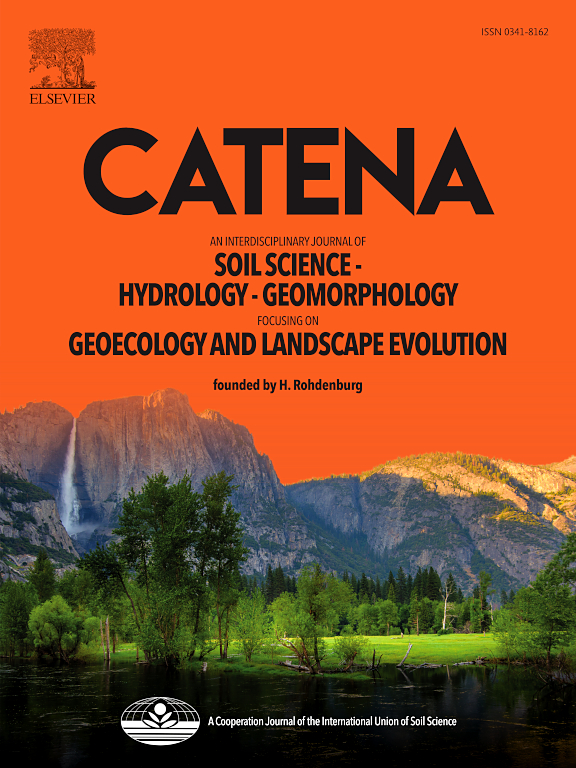A method for calculating the oblique cross-slope tillage factor
IF 5.7
1区 农林科学
Q1 GEOSCIENCES, MULTIDISCIPLINARY
引用次数: 0
Abstract
In regions with rolling hills, oblique cross-slope tillage is more common than contour or up-and-down slope tillage. However, its role in soil erosion assessments has been largely overlooked, and the impact of contour tillage has often even been disregarded due to the limitations of existing evaluation methods. To address these gaps, a novel soil erosion factor—the oblique cross-slope tillage subfactor (To)—was proposed, and a raster-based method was developed to accurately quantify the influence of the furrow direction on soil erosion. Using a 28 km2 watershed in northeastern China as a case study, tillage lines were digitized from satellite images, and furrow contour angles were computed on the basis of their relationships with contour lines. The furrow direction modification coefficient relative to contour tillage was then used to derive To. Soil erosion was assessed both with and without To. The results showed that oblique cross-slope tillage covered 46.1 % of the study area, and the exclusion of To resulted in a 26.5 % overestimation of erosion rates, highlighting the importance of incorporating To into soil erosion assessments. The furrow contour angle varied significantly within parcels, with an average variation of 70.8°. The grid-based method for calculating To was more accurate and practical than traditional parcel-based approaches. To effectively captures the impact of oblique cross-slope tillage at various angles and could serve as a universal substitute for specific cases of contour and up-and-down slope tillage. Incorporating To into soil erosion models could increase their accuracy and provide more reliable guidance for soil conservation planning.
一种斜斜交叉耕作系数的计算方法
在丘陵起伏地区,斜斜交叉耕作比等高线或上下坡耕作更为常见。然而,等高线耕作在土壤侵蚀评价中的作用在很大程度上被忽视,而且由于现有评价方法的局限性,等高线耕作的影响往往被忽视。为了解决这些差距,提出了一种新的土壤侵蚀因子-斜斜斜坡耕作子因子(To),并开发了一种基于栅格的方法来准确量化犁沟方向对土壤侵蚀的影响。以中国东北28 km2流域为例,对卫星影像的耕作线进行数字化处理,并根据其与等高线的关系计算出犁沟等高线角。然后利用等高线耕作的垄沟方向修正系数,得到。对土壤侵蚀进行了评价。结果表明,研究区46.1%的土地面积为斜斜斜斜耕作,而不考虑斜斜斜斜耕作导致土壤侵蚀率高估26.5%,凸显了将斜斜斜斜耕作纳入土壤侵蚀评估的重要性。垄沟轮廓角在地块内变化显著,平均变化幅度为70.8°。与传统的基于包裹的计算方法相比,基于网格的计算方法更加准确和实用。有效捕捉不同角度斜斜交叉耕作的影响,可作为等高线和上下坡耕作特定情况的通用替代。将To引入土壤侵蚀模型可以提高模型的准确性,为土壤保持规划提供更可靠的指导。
本文章由计算机程序翻译,如有差异,请以英文原文为准。
求助全文
约1分钟内获得全文
求助全文
来源期刊

Catena
环境科学-地球科学综合
CiteScore
10.50
自引率
9.70%
发文量
816
审稿时长
54 days
期刊介绍:
Catena publishes papers describing original field and laboratory investigations and reviews on geoecology and landscape evolution with emphasis on interdisciplinary aspects of soil science, hydrology and geomorphology. It aims to disseminate new knowledge and foster better understanding of the physical environment, of evolutionary sequences that have resulted in past and current landscapes, and of the natural processes that are likely to determine the fate of our terrestrial environment.
Papers within any one of the above topics are welcome provided they are of sufficiently wide interest and relevance.
 求助内容:
求助内容: 应助结果提醒方式:
应助结果提醒方式:


